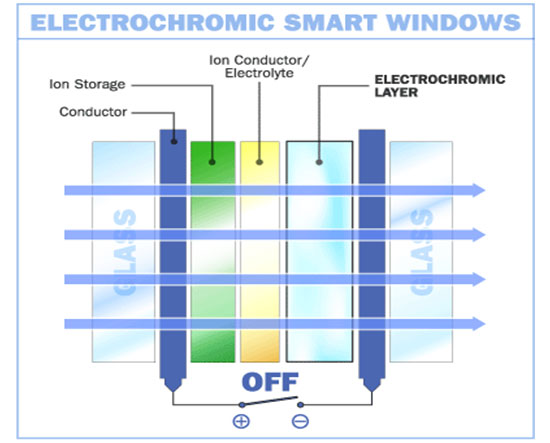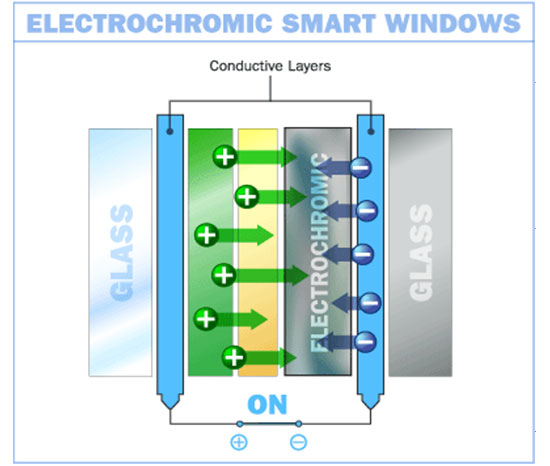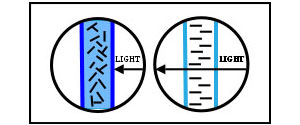Smart Glass Applications with Polymer Dispersed Liquid Crystal (PDLC) Technology
Applications for PDLC switchable glass range from residential to corporate to health care and retail, while the practical, functional benefits include privacy, display, energy savings, comfort and, it must be said, the wow factor.
That wow factor comes alive in an open-concept law office, for example, where a centrally located conference room bounded by clear glazing becomes a private sanctuary for client meetings and depositions after the glazing turns opaque with the flip of a switch or building system control through automation integration.
In a residential setting, the occupants enjoy unobstructed city or landscape views from extensive lavatory or bathing area glazing, and then enjoy the privacy of opaque/tinted glass when privacy is desired, again with the push of a button or even commands from a smart phone or home automation system.
In retail or health care, spaces are fully exposed or protected with privacy as needs and wants indicate. In retail or auto dealer environments, projected videos can attract customers.
The range of applications for PDLC smart glass will be examined more thoroughly at the end of the course. But first, it’s helpful to understand each of the major technologies used for switchable glass, and to understand the benefits and drawbacks of each technology in order to select the right specification for the project.
Passive and Active Smart Glass Technologies and Their Best Applications
Smart glass technologies include photochromic, thermochromic, electrochromic, suspended particle, and liquid crystal device technologies.

Provided by Glass Apps
While the basic concept behind all smart windows is the same, they can be made in several different ways, each with a different method and properties for blocking light and/or views. Critical aspects of smart glass include material costs, installation costs, electricity costs and durability, as well as functional features such as the speed of control, possibilities for dimming, and the degree of transparency.
Smart glass technologies fall into two categories: passive and active.
Passive Smart Glass Technologies
Passive smart glass technologies respond to non-electrical stimuli and thus cannot be controlled manually. These include thermochromic, which reacts to heat, and photochromic, which responds to light.
A simplistic view of thermochromic windows is that the windows are tinted during the summer and are clear during the winter, with the assumption that thermochromic windows switch based on outdoor air temperature.
Photochromic simply means something that changes color in response to light. In relation to sunglasses, photochromic lenses darken or lighten depending on their exposure to ultraviolet (UV) radiation. Photochromic technology is mostly used in eyeglasses (which tint depending on the amount of light).
With these technologies, glass will limit or expand light transmission depending on the temperature or the amount of light present. For window glass, the timing factor could be problematic. Anyone who has gone from outdoors to indoors wearing these photochromic glasses, and has had to deal with the issue of glasses still darkened from the outside light, could see the advantage of controlling the lightening or darkening depending on one’s needs and circumstances.
Active Smart Glass Technologies
Active smart glass technologies respond to an electrical stimulus and are therefore controllable by the user. They include electrochromic, suspended particle device (SPD) and polymer dispersed liquid crystal (PDLC) technologies.
Electrochromic
Electrochromic uses electricity to turn the glass from clear to dark.


Images courtesy of Glass Apps
Electrochromic glass is typically used for solar control on exterior glass. The visible light transmission in the darkest state can be less than 3%. The resulting shading has limited privacy function as it can still be seen through.
Electrochromic windows consist of two glass panes with several layers sandwiched in between. It works by passing low-voltage electrical charges across a microscopically thin, clear conductive coating on the glass surface, which activates electrochromic layers that change color from clear to dark.
The electric current can be activated manually or by sensors which react to light intensity. One advantage of the electrochromic smart window is that it only requires electricity to change its opacity, but not to maintain a particular shade. This type of technology requires new glass installation, as there is no commercial film option to apply on existing glass.
The switching speed of electrochromic glass is very slow and varies depending upon the size of the panel (larger panels typically take many minutes to switch). The consistency of tint changes also varies, with larger panels sometimes exhibiting tint changes that begin at the glazing’s outer edges and then move inward (known as the “iris effect”).
Suspended Particle Device Technology

Image courtesy of Glass Apps.
In SPD technology, when voltage is applied, the suspended particles align and let light pass.
Suspended particle devices (SPDs) respond to AC power to turn the glass from dark to clear.
SPDs are ideal for such light control applications as skylights, auto glass, sunroofs, aircraft windows, and marine windows and portholes.
In suspended particle devices (SPDs), a thin film laminate of rod-like nano-scale particles is suspended in a liquid and placed between two pieces of glass or plastic, or attached to one layer. When no voltage is applied, the suspended particles are randomly organized, thus blocking and absorbing light. When voltage is applied, the suspended particles align and let light pass. Varying the voltage of the film varies the orientation of the suspended particles, thereby regulating the tint of the glazing and the amount of light transmitted. The visible light transmission at the darkest state of SPD glazing is around 0.5% and the process takes one to three seconds after power is applied, regardless of the size of the window. The resulting dark blue shading blocks light and provides only partial privacy.
Polymer Dispersed Liquid Crystal Switchable Technology
The third type of active smart glass technology, and the focus of this learning unit, is polymer dispersed liquid crystal (PDLC). This technology controls light diffusion to turn the glazing from opaque to clear using AC power. In this technology, the glazing goes from opaque to clear or from clear to opaque in milliseconds, regardless of the window size.
In the opaque state, more than 96% of the parallel light is blocked resulting in excellent privacy although around 80% of the total light transmits through the glazing. When switched to clear, you can see through the material like a piece of glass with about 86% total light transmission. We’ll examine how this technology works in the next section.









